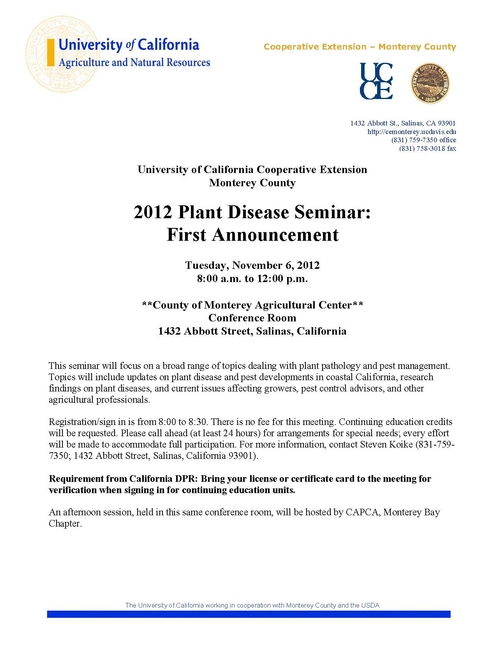- Author: Steven T. Koike
2012 Pl Dis Sem annouce
- Author: Steven T. Koike
2012PlDisSemFirstNew
- Author: Steven T. Koike
Along with researchers in Europe, Jim Correll (Univ. Arkansas) and Steven Koike (UC Cooperative Extension, Monterey County) report here another new race, the 14th, of the downy mildew pathogen (Peronospora farinosa f. sp. spinaciae) of spinach. First identified in November 2010 from spinach in Ventura County, California, this race breaks the resistance of several important cultivars. The isolate was initially designated as UA4410 and was characterized with a standard set of differential varieties. Isolates with the same disease reaction as UA4410 were subsequently found in locations throughout California and Arizona in 2011 and 2012. This race has not been reported in Europe. After careful evaluation of the significance of this development to the spinach industry, the International Working Group on Peronospora (IWGP) has designated this isolate as race Pfs: 14. Isolate UA4410 will be the type isolate (or official isolate) of Pfs: 14. The IWGP is located in The Netherlands and is administered by Plantum NL.
Race Pfs: 14 poses a threat to the spinach industry because it is particularly well-adapted to modern hybrids with resistance to races 1-13. Similar developments have taken place when races Pfs: 5 (1996), Pfs: 6 (1998), Pfs: 7 (1999), Pfs: 8 and 10 (2004), Pfs: 11 (2008), Pfs: 12 (2009), and Pfs: 13 (2011) were identified and named. The occurrence of Pfs: 14 will encourage development and eventual use of Pfs: 1-14 resistant spinach cultivars.
A collaboration of researchers with the IWGP, University of Arkansas (Correll), and University of California (Koike) is monitoring the development of new races of spinach downy mildew on a global scale by continuously collecting and testing suspected new isolates. Collected field samples are tested for race identification using a fixed, standardized host differential set of varieties that contains the full range of available resistances. New race designations will be mutually agreed upon by this collaboration based on persistence of the race over several years, occurrence in a wide area, and significant economic impact. In this way it is hoped that research findings and conclusions will be agreed upon and better communicated between the researchers, seed industry, spinach growers, and other interested parties.
For California and Arizona, the Correll-Koike team will continue to receive and test spinach downy mildew samples for growers, pest control advisors, and seed companies. Industry is encouraged to continue to submit downy mildew outbreak samples to Correll-Koike, as such samples facilitate the discovery of additional new races. The Correll-Koike research is made possible by support from the California Leafy Greens Research Board and by active participation from the agricultural industries in California and Arizona.
The IWGP consists of spinach seed companies (Pop Vriend, Monsanto, Rijk Zwaan, Nunhems, Takii, Sakata, Bejo, Enza, Syngenta, Vilmorin, and Advanseed) and Naktuinbouw (the Inspection Service for Horticulture in The Netherlands), and is supported by researchers at the University of Arkansas and the University of California Cooperative Extension (Monterey County) in the USA. Researchers all over the world are invited to join the IWGP initiative and use the common host differential set to identify new isolates.
For more information on this subject you can contact Steven Koike (stkoike@ucdavis.edu), Jim Correll (jcorrell@uark.edu), Diederik Smilde (d.smilde@naktuinbouw.nl), or IWGP chairperson Jan de Visser (JandeVisser@popvriendseeds.nl).
- Author: Richard Smith
The lack of rain in the Salinas Valley brings many concerns. The lack of runoff into lakes San Antonio and Nacimiento of course is a concern for the availability of water to run down the river to recharge the ground water for irrigation purposes. In addition, the lack of rain will affect the levels of salts that remain up in the root zone of the crops. Soil nitrate (NO3-) is one of the anions that will remain in the soil if leaching by winter rains does not occur. Nitrate is highly mobile and can be easily leached with just one or more significant rain storms; figure 1 illustrates nitrate leached from the top foot of soil by a series of storms that delivered 2.0 inches of water over the course of one week in the winter of 2010. High residual soil nitrates may come from several sources: 1) unused fertilizer from the previous crops or fall preplant nitrogen applications; 2) mineralization of crop residues from the previous crop; and 3) mineralization of soil organic matter over the winter (mineralization of soil organic matter is much slower during the winter but will still occur to a minimal degree).
We recently surveyed several soils looking for a site to conduct a fertilizer trial and observed that residual soil nitrate levels were routinely over 20 ppm nitrate-nitrogen. These levels were in contrast with levels that we observed last year following a wet spring where, in general, residual soil nitrate levels were in the 5 – 10 ppm nitrate-nitrogen range. The difference in conditions between a dry winter like this and a wet winter like last year is that it has implications for planning nitrogen fertilizer programs; with soil residual nitrate levels this high, the nitrogen fertilizer needs of the first crop fields will behave like second crop fields in that the robust amounts of residual soil nitrate in the soil that can provide for the crop needs and allow you to reduce nitrogen fertilizer programs.
To illustrate this point, we observed a great difference in the fertilizer needs of first vs second crop spinach during the 2011 growing season. In a first crop spinach planting, residual soil nitrate levels were at 5 ppm at the beginning of the trial. Spinach responded to at-planting applications of nitrogen up to 40 lbs nitrogen/A (Figure 2). The second crop spinach planting had initial levels of residual soil nitrate of 28 ppm nitrate-nitrogen which allowed the grower to skip the at-planting nitrogen application; he made one top-dress nitrogen application two weeks after planting to bring the crop to harvest. The results of a top-dress nitrogen evaluation indicated that there was no improvement in yield beyond 25 lbs nitrogen per acre (Figure 3).
These results indicate the importance of deep percolation of water on residual levels of soil nitrate. Winter rains have the beneficial effect of leaching salts from the soil. It is very unfortunate that nitrate is one of the salts that is leached with the water, but that is the case. In many of the discussions that we have had over the last several years regarding managing nitrogen fertilization more efficiently, we have emphasized that testing for residual soil nitrate is generally most effective for the second crop of the season. However, given the extreme lack of leaching rain events this winter, residual soil nitrate levels are also high at the beginning of the first crop in many areas in the valley and can be taken into consideration when planning nitrogen fertilization.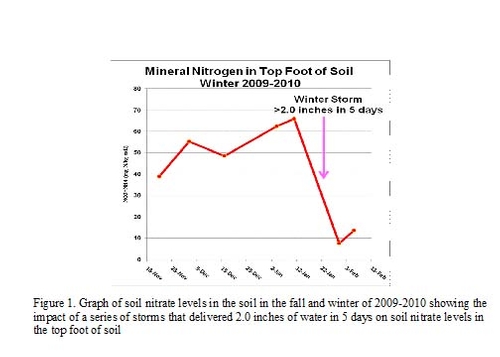
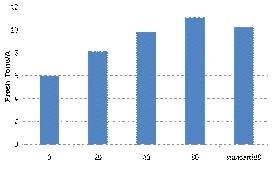
Figure 2. Yield response of first crop spinach under five
application rates of at-planting nitrogen (0 – 80 lbs N/A)
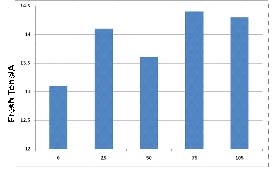
Figure 3. Yield response of second crop spinach under five application rates of top-dressed nitrogen (0 – 105 lbs N/A); no at-planting nitrogen was applied to this planting.
- Author: Jim Correll, University of Arkansas Steven Koike, University of California Cooperative Extension
Another new race, the 13th, of the downy mildew pathogen (Peronospora farinosa f. sp. spinaciae) of spinach has been found and documented. First identified in January 2010 from spinach in Holtville, California, this race breaks the resistance of several important cultivars. The isolate was initially designated as UA0510C and was characterized with a standard set of differential varieties. Isolates apparently identical to UA0510C have been found in an increasing number of locations throughout California in 2010 and 2011. After careful evaluation of the significance of this development to the spinach industry, the International Working Group on Peronospora (IWGP) has designated this isolate as race Pfs 13. The IWGP is located in The Netherlands and is administered by Plantum NL.
Race Pfs 13 poses a threat to the spinach industry because it is particularly well-adapted to modern hybrids with resistance to races 1-12. The appearance of a new race is not unexpected because hybrids with resistance to races 1-12 have been widely planted over the past few years. Similar developments have taken place when races Pfs 5 (1996), Pfs 6 (1998), Pfs 7 (1999), Pfs 8 and 10 (2004), Pfs 11 (2009), and Pfs 12 (2009) were identified and named. The occurrence of Pfs 13 will clearly encourage the industry to develop and use new spinach cultivars having resistance to races 1-13. A history of the detection of the various spinach downy mildew races is presented in Table 1.
A collaboration of researchers with the IWGP, University of Arkansas (Correll), and University of California (Koike) is monitoring the development of new races of spinach downy mildew on a global scale by collecting and testing suspected new isolates. In this way it is hoped that research findings and conclusions will be agreed upon and better communicated between the seed industry, spinach growers, and other interested parties. For California and Arizona, the Correll-Koike team will continue to receive and test spinach downy mildew samples for growers, pest control advisors, and seed companies. Industry is encouraged to continue to submit downy mildew outbreak samples to Correll-Koike, as such samples facilitate the discovery of additional new races. The Correll-Koike research is made possible by support from the California Leafy Greens Research Board and by active participation by the agricultural industries in California and Arizona.
For more information on this subject you can contact Steven Koike (stkoike@ucdavis.edu), Jim Correll (jcorrell@uark.edu), Diederik Smilde (d.smilde@naktuinbouw.nl), or IWGP chairperson Jan de Visser (JandeVisser@popvriendseeds.nl).
Table 1. Races of spinach downy mildew and year of detection
| Year | Race |
| 1824 | 1 |
| 1958 | 2 |
| 1976 | 3 |
| 1990 | 4 |
| 1996 | 5 |
| 1998 | 6 |
| 1999 | 7 |
| 2004 | 8 |
| ... | (9)* |
| 2004 | 10 |
| 2008 | 11 |
| 2009 | 12 |
| 2010 | 13 |
*One time detection only
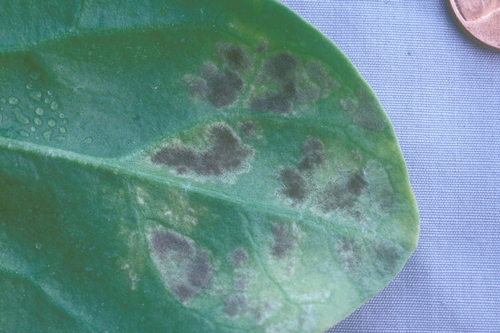
Downy mildew of spinach is the most important disease on this crop and results in quality and yield losses.


